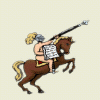Sunni and Shia
Tayfun Balçik

Scène uit The Last Temptation of Christ
Last month blogger and historian Tayfun Balçik interviewed Bangladeshi writer and activist Parvez Alam in front of a live audience as part of the The Hague Peace Projects. Alam is an expert in the history of Islam, especially the historical development of Islam. During the talk, a transcription of which will be published in four installments (read the first installment), several subjects were explored, like the relationship between Arab nationalism and Islam and the roots of the Sunni-Shia divisions.
We’ve mainly talked about the Sunni side of Islam, can you also say something about the Shia?
“The word Shia comes from the Arabic Shiʻatu Alī, which means party or followers of Ali. But when you say ‘we have talked about the Sunni side of Islam, and let’s jump now to Shia Muslims’, it’s actually not like that. Because the time we were talking about, the earliest period, there was no Sunni or Shia.”
Okay, then when was this division?
“During the reign of Ali. Ali is the fourth caliph. But his caliphate was disputed by the Ummayad dynasty. For them Ali was an imposter. So for the Umayyads, Muawiya is the fourth caliph. On the other hand, the Shia consider Ali not as the fourth caliph, but as the first legitimate caliph. The first imam, as they call him. The Iranian Shia, which we call the twelver Shia, don’t recognize the legitimacy of the first three caliphs (Abu Bakr, Umar and Uthman), only that of Ali. But what I want to say is that ‘Sunni’ as an identity came much later.”
And the Shia identity?
“During the time of Ali.”
So the Shia identity came earlier than the Sunni one?
“Yes, of course. Let’s focus on the word Sunni now. When did this become important? During the Abbasid period. That is at least two hundred years after the death of the prophet. Sunna means ’tradition’. Even before Islam, in the Syriac language, you had the word ‘sunna’, which means ‘law’. Until the Ummayad period you see that sunna could be anyone’s sunna. The caliph’s sunna, a tribal head’s sunna or the sunna of a religious leader, ascetic etc. At a certain point, with all the sunnas that existed in the Muslim world, some of the hadith compilers created a chain of narration and made the prophet as the narrator of all this tradition, they made the prophet the source of all this sunna.”
Like a Mohammedan monopoly on all sunnas.
“Yes, the interesting thing is that if you look at the oldest hadith, you’ll find not only Muhammad’s sunna, but other companion’s sunnas are also mentioned.”
Is this accepted in the Muslim community, or is it controversial to say these things?
“This is well documented by Muslims themselves. And nowadays the scholarly tradition has made progress; there is a good theory about the traditions that can determine which traditions trace back to the first century of Islam, maybe not to the prophet, but definitely to the first century of islam.”
What was the dispute beteen Ali and Muawiya?
“Okay, let me give some basic facts about the early history of Islam. After the prophet died, the new leader of the Muslim community was called the caliph. The first one was Abu Bakr, the second caliph was Umar. During this period, the Muslims conquered Persia, Syria and Egypt. During the time of the third caliph, Uthman, civil disobedience broke out, Egypt and two cities in Iraq rebelled, only Syria, which was controlled by the third caliph’s family, didn’t rebel.”
A civil war between Sunni and Shia?
“It started as a rebellion. Then Uthman, the third caliph was killed and after he was killed, the rebels made Ali the caliph in Medina.”
Question from the audience: if you leave God aside, what would make the division between Sunnis and Shias, from a more empirical point of view?
“That is what I’m telling now, I’m talking about political history, the third caliph was murdered and the rebels chose Ali as new caliph, but the third caliph’s clan, who ruled from Syria, didn’t recognize Ali’s caliphate, they were asking for a trial for the murder of the third caliph. Together with one of the prophet’s wives, Aisha, they all rebelled against the fourth caliph. Those who supported Ali in this conflict were the Shiat al Ali. They are considered as the first Shia. So that is what the dispute is about.’
To be continued….
Tayfun Balçık is a historian, specialized in the modern history of Turkey and Amsterdam-West, one of the project-coördinators of the Turkish-Kurdish dialogue program at The Hague Peace Projects and he gives Dutch language lessons to Turkish elderly people. He has a Facebook-page.
English, Tayfun Balçik, 01.04.2017 @ 09:53
2 Reacties
op 17 04 2017 at 22:36 schreef Hadi:
Beste mensen
Ik vind het jammer dat er bijna niemand in Nederland iets weet over de Islam (ik weet het, nu gaat iedereen zeggen, ja hij heeft het alleen daarover), maar als je nog een paar minuten geduld hebt kan ik dat toelichten.
Voorbeeld : dit artikel is van (Parvez Alam in front of a live audience as part of the The Hague Peace Projects. Alam is an expert in the history of Islam, especially the historical development of Islam) ik zal kort even uitleggen hoeveel fouten dit stukje bevat.
********
Vanaf nu stukken Tussen {…} betekend dat ze zijn gekopieerd van artikel zelf.
1 – {The word Shia comes from the Arabic Shiʻatu Alī, which means party or followers of Ali. But when you say ‘we have talked about the Sunni side of Islam, and let’s jump now to Shia Muslims’, it’s actually not like that. Because the time we were talking about, the earliest period, there was no Sunni or Shia.}
In het eerste alinea (the earliest period, there was no Sunni or Shia) dit klopt niet, juist omdat de eerste persoon die praat over de shia of shiiatu Ali was de profeet Mohammed (vzmh) en het bewijs is afkomstig vanuit soennitische boeken, (Ik geef voor elke punten een bewijs/bron en de geïnte
op 17 04 2017 at 22:55 schreef Hadi:
…geïnteresseerd voor meer info kunnen het even opzoeken.
(Dit (Ali) en zijn volgelingen in de Dag des Oordeels zijn winnaars)
Afbeelding 1
http://sonnat.net/upload/article/B75093A2.004F.430D/RYVVD2X6_pic.gif?rnd=
Link van de schrijvers boek die afbeelding werd gekopieerd
https://en.wikipedia.org/wiki/Al-Suyuti
********
En er zijn ook bewijzen dat in de periode waarin de profeet leefde waren er Sahaba’s die Ali’s sjia waren
Bijvoorbeeld : Saeed bin Wahab Al-Hamdani Khaiwani Alkofi was een grote Ali’s sjia in de periode waar Gods profeet leefde.
Afbeelding 2
Link van de schrijvers boek die afbeelding werd gekopieerd
https://en.wikipedia.org/wiki/Al-Dhahabi
*******
Dit staat alleen maar in de eerste alinea en in deze hele artikel zitten er veel soortgelijke deze fouten.
Ik ga niet hier alles onder de loop nemen, maar dw bedoeling was om duidelijk te maken waarom er in Nederland niemand iets van de Islam weet, meer dan 98% van de boeken over de islam die je in boekwinkels kan vinden zijn fout. Ik wens iedereen en verstandig gezonde geest.






 RSS
RSS